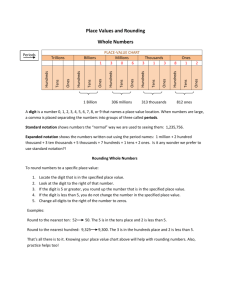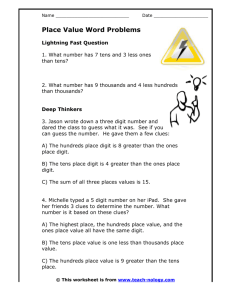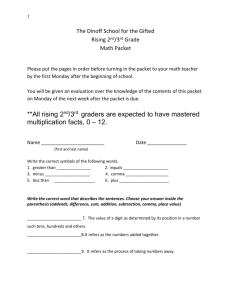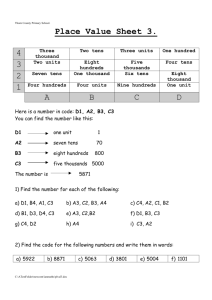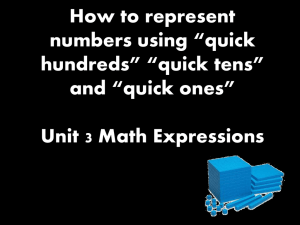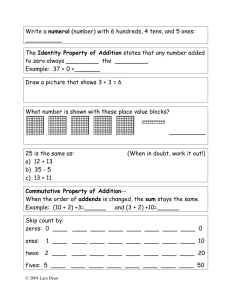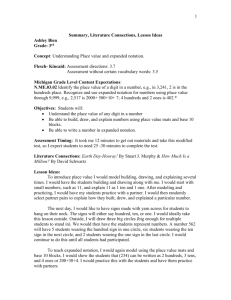Chapter 2: Numeration
advertisement
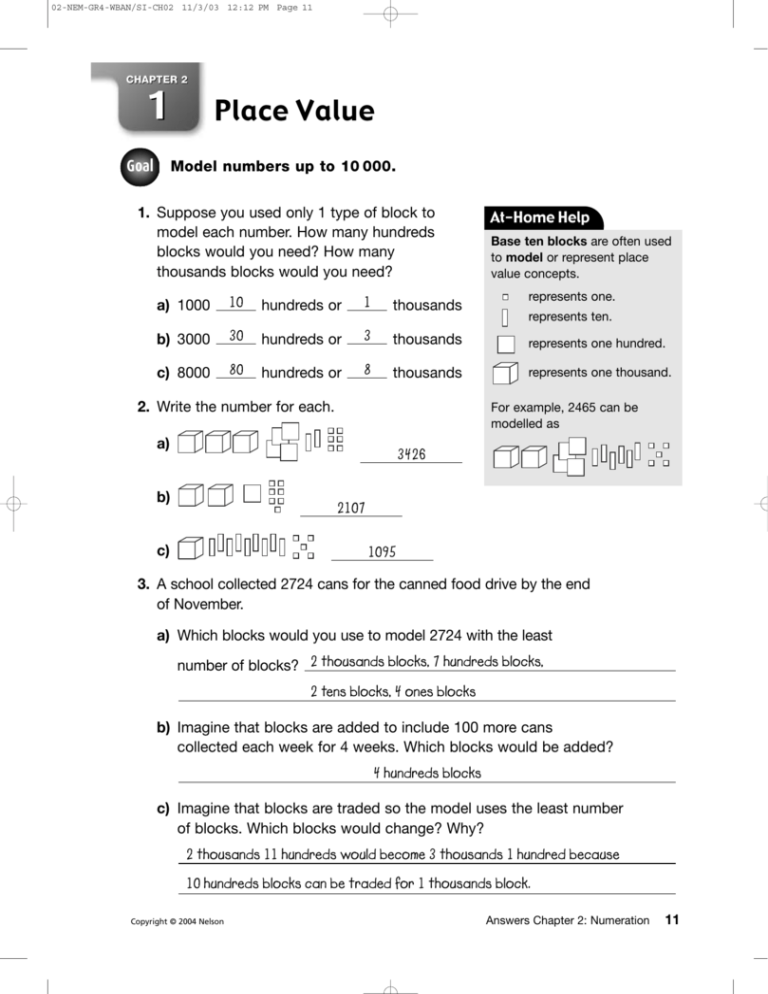
02-NEM-GR4-WBAN/SI-CH02 11/3/03 12:12 PM Page 11 CHAPTER 2 1 Goal Place Value Model numbers up to 10 000. 1. Suppose you used only 1 type of block to model each number. How many hundreds blocks would you need? How many thousands blocks would you need? At-Home Help Base ten blocks are often used to model or represent place value concepts. represents one. hundreds or 1 30 hundreds or 3 thousands represents one hundred. 80 hundreds or 8 thousands represents one thousand. a) 1000 10 b) 3000 c) 8000 thousands 2. Write the number for each. represents ten. For example, 2465 can be modelled as a) 3426 b) 2107 c) 1095 3. A school collected 2724 cans for the canned food drive by the end of November. a) Which blocks would you use to model 2724 with the least number of blocks? 2 thousands blocks, 7 hundreds blocks, 2 tens blocks, 4 ones blocks b) Imagine that blocks are added to include 100 more cans collected each week for 4 weeks. Which blocks would be added? 4 hundreds blocks c) Imagine that blocks are traded so the model uses the least number of blocks. Which blocks would change? Why? 2 thousands 11 hundreds would become 3 thousands 1 hundred because 10 hundreds blocks can be traded for 1 thousands block. Copyright © 2004 Nelson Answers Chapter 2: Numeration 11 02-NEM-GR4-WBAN/SI-CH02 11/3/03 12:12 PM Page 12 CHAPTER 2 2 Goal 1. Expanded Form Write numbers up to 10 000 in expanded form. Thousands Hundreds Tens Ones 2 1 8 4 Write the modelled number 2184 a) in standard form b) in expanded form using numbers At-Home Help When a number is written in the usual way, for example 4675, it is in standard form. In expanded form, 4675 is written as 4000 600 70 5 or as 4 thousands 6 hundreds 7 tens 5 ones. We read 4675 as 4 thousand 6 hundred seventy-five. 2000 + 100 + 80 + 4 2 thousands + 1 hundred + 8 tens + 4 ones c) in expanded form using words 2 thousand 1 hundred eighty-four d) as you would read it 2. Write each number in expanded form using words. a) 6734 6 thousands + 7 hundreds + 3 tens + 4 ones b) 3208 3 thousands + 2 hundreds + 8 ones c) 9777 9 thousands + 7 hundreds + 7 tens + 7 ones 3. Write each number in standard form. b) 8000 800 80 8 a) c) 7 thousands 6 tens 2 ones 8888 7062 3506 12 Answers Chapter 2: Numeration Copyright © 2004 Nelson 02-NEM-GR4-WBAN/SI-CH02 11/3/03 12:12 PM Page 13 CHAPTER 2 3 Goal Comparing and Ordering Numbers Compare and order numbers up to 10 000. 1. Here are the masses of some heavy animals. elephant 6168 kg giraffe 1364 kg rhinoceros 2273 kg baby whale 3636 kg bison 1182 kg hippopotamus 3207 kg At-Home Help When comparing numbers, you can use the symbols < and >. The symbol < means that the 1st number is less than the 2nd number. The symbol > means that the 1st number is greater than the 2nd number. The symbols < and > always point to the lesser number (e.g., 1805 < 5920 and 5920 > 1805). a) Which animal is the heaviest? Explain how you know. The elephant is the heaviest. The mass of the elephant has the greatest thousands digit. b) Which animals have a mass of between 2000 kg and 4000 kg? rhinoceros, baby whale, hippopotamus c) Which animal is heavier, the giraffe or the bison? Explain how you know. The giraffe is heavier. Both have a 1 in the thousands place, but the hundreds digit is greater in the mass of the giraffe. d) Order the animals from lightest to heaviest. bison, giraffe, rhinoceros, hippopotamus, baby whale, elephant 2. Complete by using <, , or >. a) 8882 > 987 b) 2815 < 2968 c) 6200 < 8602 d) 5432 > 4523 3. Write each set of numbers in order from least to greatest. a) 7450, 6871, 7531, 784 784, 6871, 7450, 7531 b) 5871, 5873, 5997, 5888 5871, 5873, 5888, 5997 Copyright © 2004 Nelson Answers Chapter 2: Numeration 13 02-NEM-GR4-WBAN/SI-CH02 11/3/03 12:12 PM Page 14 CHAPTER 2 4 Goal Exploring 10 000 Explore place value patterns to 10 000. 1. Write the first 5 numbers in each pattern. At-Home Help These numbers show skip counting by 20s: 9900, 9920, 9940, 9960, 9980. The pattern can be described as starting at 9 thousands 9 hundreds with the tens digit increasing by 2 for each number. a) The pattern starts with 6 thousands. The number of thousands increases by 1 for each number. 6000, 7000, 8000, 9000, 10 000 b) The pattern starts with 9 thousands 9 hundreds 8 tens. The number of ones increases by 5 for each number. 9980, 9985, 9990, 9995, 10 000 c) The pattern starts with 9 thousands 9 hundreds 2 tens. The number of tens increases by 2 for each number. 9920, 9940, 9960, 9980, 10 000 d) The pattern starts with 9 thousands 2 hundreds. The number of hundreds increases by 2 for each number. 9200, 9400, 9600, 9800, 10 000 2. Complete each pattern by filling in the missing numbers. a) 5000, 6000, 7000 , 8000, 9000, b) 2000, 4000, 6000 , c) 9960, 9970 , 9980, 9990, d) 9750, 9800, 9850, e) 9995, 9996, 9900 9997 Answers Chapter 2: Numeration , 10 000 10 000 , 9950, , 9998, f ) 9990, 9992, 9994, 9996, 14 8000 9998 10 000 9999 , 10 000 , 10 000 10 000 Copyright © 2004 Nelson 02-NEM-GR4-WBAN/SI-CH02 11/3/03 12:12 PM Page 15 CHAPTER 2 5 Goal Multiplying by 10, 100, and 1000 Multiply by 10, 100, and 1000. 1. Multiply. At-Home Help 70 a) 7 10 c) 50 10 290 b) 29 10 d) 321 10 500 3210 When you multiply 3, for example, by 10, you have 3 groups of 10. There are 3 tens and 0 ones. So 3 10 30. 2. What pattern do you see in your answers to Question 1? There is a zero at the end of each number that is multiplied by 10. 3. Multiply. 500 a) 5 100 b) 38 100 3800 c) 70 100 7000 d) 100 100 10 000 4. What pattern do you see in your answers to Question 3? There are 2 zeros at the end of each number that is multiplied by 100. 5. Multiply. a) 2 1000 2000 c) 9 1000 9000 b) 5 1000 5000 d) 10 1000 10 000 6. What pattern do you see in your answers to Question 5? There are 3 zeros at the end of each number multiplied by 1000. 7. What is the missing number? a) 3000 3 1000 c) 6000 6 1000 b) 3000 30 100 d) 6000 60 100 8. What is the missing number? a) 4290 429 10 c) 7500 750 10 b) 3060 306 10 d) 9000 900 10 Copyright © 2004 Nelson Answers Chapter 2: Numeration 15 02-NEM-GR4-WBAN/SI-CH02 11/3/03 12:12 PM Page 16 CHAPTER 2 6 Goal Rounding to the Nearest 10, 100, or 1000 Round numbers to the nearest 10, 100, or 1000. 1. There are 4906 grade 4 students in the OttawaCarleton school district. Round this number to a) the nearest thousand 5000 b) the nearest hundred 4900 c) the nearest ten 4910 2. a) Draw a number line to show how you would round the greatest depth of the Atlantic Ocean to the nearest thousand. Ocean/Sea Greatest depth (m) Indian Ocean 7455 Atlantic Ocean 9219 Arctic Ocean 5625 Caribbean Sea 6946 At-Home Help There are times when it is useful to use approximate numbers. One way to do this is to round numbers to the nearest 10, 100, or 1000. To do this, find the multiple of 10, 100, or 1000 that the number is closest to. 2462 rounded to the nearest thousand is 2000. 2462 rounded to the nearest hundred is 2500. 2465 rounded to the nearest ten is 2470. 9219 9000 9100 9200 9300 9400 9500 9600 9700 9800 9900 10 000 b) What is the greatest depth of the Indian Ocean rounded to 7000 the nearest thousand? c) What is the greatest depth of the Indian Ocean rounded to 7500 the nearest hundred? d) What is the greatest depth of the Arctic Ocean rounded to the nearest thousand? 6000 e) What is the greatest depth of the Arctic Ocean rounded to the nearest hundred? 5600 f ) Explain why the greatest depths of the Caribbean Sea and the Indian Ocean are both 7000 m when rounded to the nearest thousand. The greatest depth of the Caribbean Sea is less than 7000 m, but it is closer to 7000 m than to 6000 m. The greatest depth of the Indian Ocean is more than 7000 m, but it is closer to 7000 m than to 8000 m. 16 Answers Chapter 2: Numeration Copyright © 2004 Nelson 02-NEM-GR4-WBAN/SI-CH02 11/3/03 12:12 PM Page 17 CHAPTER 2 7 Goal Communicate About Ordering Numbers Explain how to order a set of numbers in a complete, clear, and organized way. 1. Match the letters of the explanations in the boxes below to these number patterns. If you correctly match the patterns to their explanations, the letters going down will spell the number of patterns you matched. R U a) 8808, 8008, 888, 808 F b) 180, 295, 592, 801 O c) 1000, 5308, 5803, 8500 U d) 8, 81, 808, 8808 R I ordered the numbers from least to greatest with the 1-digit number first, then the 2-digit number, then the 3-digit number, and finally the 4-digit number. I looked at the digit in the thousands place and wrote the numbers from least to greatest. For the 2 numbers that have the same thousands digit, I looked at the digit in the hundreds place to decide which is the least. Copyright © 2004 Nelson F O At-Home Help The following terms help describe how a set of numbers is ordered. digits: The digits in our number system are 0, 1, 2, 3, 4, 5, 6, 7, 8, and 9. numbers: Combinations of the digits are numbers (e.g., 43, 895, and 2067). place value: A digit takes on a value determined by the place it occupies in a number. In the number 45, the digit 5 is in the ones place. Its value is 5. In the number 251, the digit 5 is in the tens place. Its value is 50. In 530, the 5 is in the hundreds place. Its value is 500. In 5296, the 5 is in the thousands place. Its value is 5000. I ordered the numbers from greatest to least. The first 2 numbers have 4 digits. I compared their hundreds digits to decide which number is greater. The last 2 numbers have 3 digits. I compared their tens digits to decide which number is greater. All of the numbers have 3 digits. I ordered the numbers from least to greatest by looking at the digit in the hundreds place. Answers Chapter 2: Numeration 17 02-NEM-GR4-WBAN/SI-CH02 11/3/03 12:12 PM Page 18 CHAPTER 2 8 Goal Counting Money Collections Estimate, count, and write money amounts up to $50.00. 1. a) Estimate how much money Hannah has. At-Home Help When counting money some regrouping is the same as place value regrouping. 1 ten-dollar bill 10 loonies 1 loonie 10 dimes 1 dime 10 pennies Answers will vary. For example, $37.00. b) Find the actual amount. $37.90 Some regrouping is different. 1 ten-dollar bill is also equal to 2 five-dollar bills or 5 toonies. 1 loonie is also equal to 4 quarters or 20 nickels. 1 quarter is also equal to 2 dimes and 1 nickel, or 5 nickels, or 25 pennies. 1 dime is also equal to 2 nickels or 1 nickel and 5 pennies. 1 nickel is equal to 5 pennies. 2. Describe bills and coins to make $5.00 in 3 different ways. Answers will vary. For example: way 1: 1 $5 bill way 2: 2 toonies, 1 loonie way 3: 5 loonies 3. Hong has 1 twenty-dollar bill, 1 five-dollar bill, 8 quarters, 8 dimes, 1 nickel, and 4 pennies. Answers will vary. a) Estimate the total amount of money he has. For example, $28.00. b) Find the actual total. $27.89 4. How would you make $22.35 using the fewest bills and coins? 1 $20 bill, 1 toonie, 1 quarter, 1 dime 18 Answers Chapter 2: Numeration Copyright © 2004 Nelson 02-NEM-GR4-WBAN/SI-CH02 11/3/03 12:12 PM Page 19 CHAPTER 2 Test Yourself Circle the correct answer. 1. Write the number for these base ten blocks. A. 317 C. 3107 B. 3170 D. 3017 2. Write 8945 in expanded form. E. 8000 900 40 5 G. 8 9 4 5 F. 8000 9000 400 5 H. 89 45 3. My thousands digit is 1 more than my hundreds digit. The sum of my thousands digit and hundreds digit is 3. My thousands digit is the same as my ones digit. My hundreds digit is the same as my tens digit. What number am I? A. 3003 B. 3030 C. 2121 D. 2112 4. Complete by choosing the correct number: 2365 > ■ E. 2425 F. 6523 G. 1365 H. 2565 C. 10 000 D. 100 000 5. Multiply: 1000 10 ■ A. 1000 B. 100 6. There are 365 days in 1 year. How many days are in 10 years? E. 365 F. 3650 G. 10 000 H. 36 500 7. What number is 1928 rounded to the nearest hundred? A. 100 B. 1930 C. 2000 D. 1900 8. Find the total amount for 1 twenty-dollar bill, 1 ten-dollar bill, 1 five-dollar bill, 3 quarters, 1 dime, and 1 nickel. E. $36.15 F. $30.90 G. $35.95 H. $35.90 9. There are 20 quarters, 5 dimes, 5 nickels, and 5 pennies in a jar. How much money is in the jar? A. $5.80 Copyright © 2004 Nelson B. $50.80 C. $6.80 D. $5.25 Answers Chapter 2: Numeration 19
